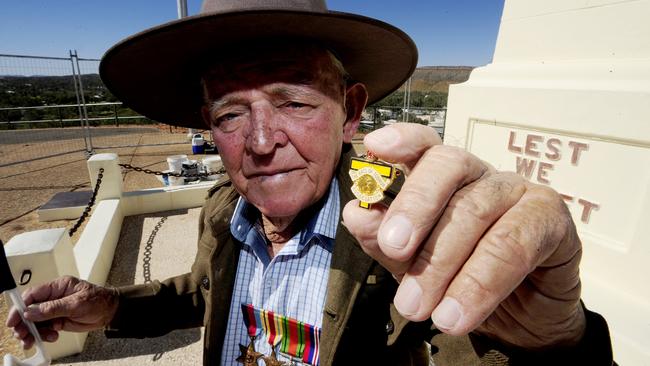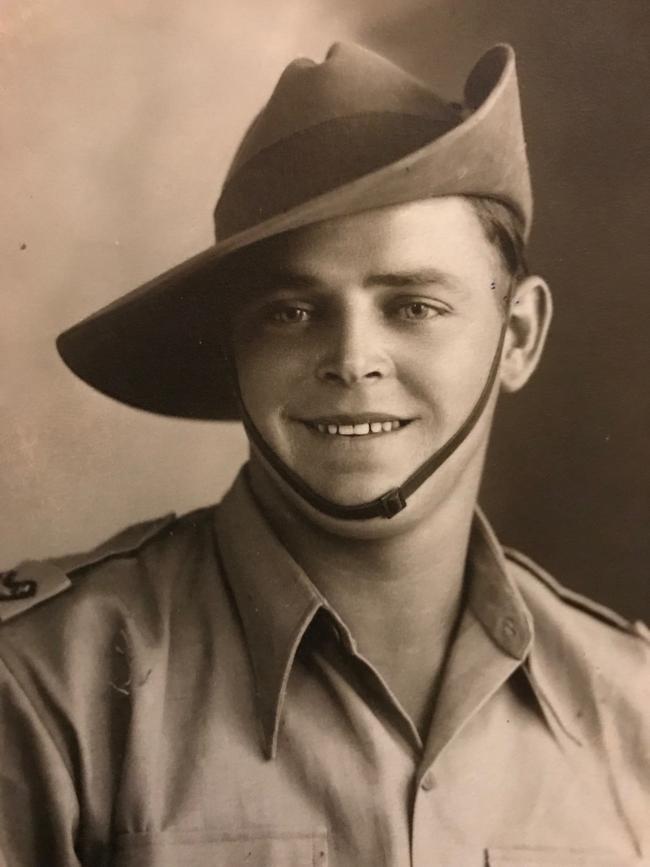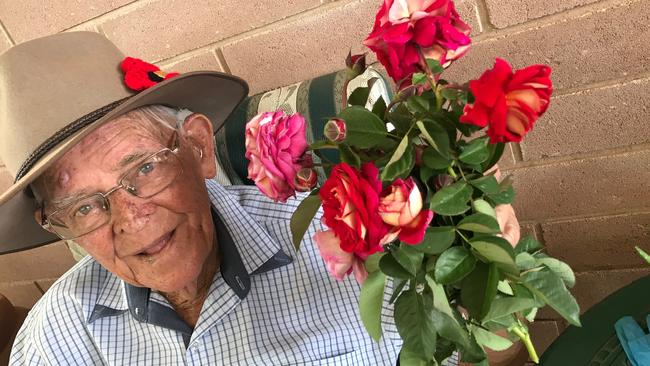
SYD Kinsman is part of the generation that history remembers as the Greatest Generation.
Their parents fought and won World War I, they themselves survived the Spanish flu and the Great Depression and then in World War II they faced the greatest evil the world had ever known – and won.
We owe an almighty debt of gratitude to Syd, his wife June and their contemporaries, who gave us this beautiful country we have today – filled with liberty, peace and prosperity.
Syd was born a little over a century ago, on July 2, 1921, in the Adelaide suburb of Thebarton.
Mum Jane and dad George had 12 kids in total; six girls – Thelma, Jean, Lila, Hazel, Eva and Elaine, and six boys – Syd, Arthur, Ron, Eddy, Bill and John.
Syd went to Hindmarsh Primary School.
“I couldn’t get it over quick enough,” he says with a laugh.
“I never missed a day but as soon as I could leave school, I did.
“I finished Grade 7, I turned 14 and I was off out into the workforce. This was the done thing back then, as it allowed you to financially contribute to the family.”
Syd worked at a steelworks that was assisting with the Australian effort to prepare for the looming war.
We now all view World War II with the comfort of knowing the end result.
But the view in July 1940 was very different.
German dictator Adolf Hitler had crushed much of Europe, conquering France in just six weeks. He began preparations to invade Great Britain. Our eventual ally Russia was at that stage on Germany’s side. Our other major eventual ally, America, was keeping itself out of the war.
The world was hanging by a thread.
It was at that moment that an 18-year-old Syd Kinsman stepped forward to fight Hitler and the Nazis on the other side of the world.

Syd and four of his mates – Ray, Tommy, Ron and Ray – enlisted to fight.
“They were calling for volunteers. We discussed it amongst ourselves and we decided it was time to go,” Syd says. “Everyone who went away were volunteers – 400,000-odd.
“The first time I went to join they turned me down. I decided to go back and I put my age up one year. I got in a different line, so that I wouldn’t get the same fella as the last time and I got in. The five of us joined the 2/48th Battalion of the Australian 9th Division.”
That was on Tuesday, July 16, 1940.
Before long Syd arrived in North Africa, where he and his comrades would soon face history’s most powerful army, led by German general Erwin Rommel – “the Desert Fox”.
“We took over from the Sixth Division. They were sent to Grecian Crete, they’d already captured Libya,” Syd says. “We first saw the enemy at Benghazi but had no contact. Rommel arrived there with brand new tanks, brand new everything. He tried to encircle us.
“We then went on what was called the ‘Benghazi Handicap’. It was a race, who could get to Tobruk first. We had the coast road to travel down. We were lucky we got there first.”
Once there, Rommel held Syd and the allied forces under siege for 241 days.
The Port of Tobruk was crucial to the control of the Suez Canal, a major artery of the war effort.
A small band of Aussies, and some other Allies, defied a merciless Nazi onslaught of ground assaults, tank warfare, shelling and bombing for nearly eight months.
Against all odds, the Australians won, beating the Germans and Italians.
Hitler came to power in 1933 and swept all before him. This was the first time he’d ever been beaten on land. And it was the Aussies who did it.
“To this day, I don’t think anyone who was in Tobruk can work out how we beat the enemy,” Syd says. “We were outnumbered and outgunned. They had better equipment.
“They were battle-hardened. We didn’t have much training. We were just thrown on a ship. Most of the training was for fitness. We didn’t know much about fighting. I had a .22 before the war, so I was pretty good at shooting.
“It was a combined effort amongst us all. The cooks, the drivers – if we didn’t have them, we couldn’t have functioned on the front line.

“The enemy thought they had it so easy. They had another thing coming, didn’t they!”
German propaganda described the Australians in Tobruk as being like “rats”. The Aussies naturally wore the moniker as a badge of honour, and thus became known as our famous “Rats of Tobruk”.
And this week, 80 years ago, the Rats of Tobruk were right in the middle of that eight-month siege.
Syd says the constant threat of death was something you “took in your stride”.
“You don’t think about a lot of things. You just get into it.”
A key to the Australians’ success, as they played David to the German Goliath, was pure guts.
No man’s land is the lethal space of ground between two opposing forces. It’s where angels fear to tread. It’s where Syd and the Aussies went.
“We owned no man’s land. It was due to patrol work – patrol, patrol, patrol. We had listening posts in no man’s land. Every night we were out there, probing the enemy, testing their strength.
“I think the enemy was on their toes, knowing the Australians were in no man’s land every night.”
Less than a month after arriving in Tobruk, Syd was shot, a burst of machine gun fire collecting him between the hip and rib cage.
“It was just a flesh wound,” he says. “It was about 17 hours until I was treated. You don’t run away with little scratches like that.”
After the siege, Syd saw service with the 9th Division in Palestine, Libya, Syria and El Alamein.
On July 10, 1942 at El Alamein, Syd was captured by Rommel’s armoured panzer division.
He was taken to Italy, moving through various camps.
Syd spent more than six months at Prisoner of War Campo 57 in Udine, Italy.
He was then moved to POW Salussola, where he was put to work in the rice fields around Vercelli in northwestern Italy.
Steve McQueen became a legend of Hollywood playing the lead role in a film about a daring escape from a POW camp.
In September 1943, Syd Kinsman did it for real.
While out on a work camp in the rice fields, Syd – along with New Zealander Laurie Jenson and another soldier named Titch – made a quick escape.
The three men’s daring quest for freedom saw them climb the Italian Alps, in darkness, with the enemy hot on their trail.
They needed to get to neutral Switzerland.
“It was a matter of who you could trust, and who you couldn’t trust. We got a bit of help here and there. We used our heads a fair bit,” Syd says.
After 10 days on the run and multiple close calls with the enemy hunting them down, Syd, Laurie and Titch crossed the border into Switzerland near the Monte Moro Pass on September 21, 1943.
The escape probably saved their lives. The remaining men Syd was captured with were later moved to Germany, where many lost their lives. Others were mistreated badly, often left with lifelong effects.
Syd was harboured in Switzerland, which was landlocked by Nazi-controlled nations, until the Allies started clawing back European soil after the D-Day landings in June of the following year.
Syd says he felt safe and grateful to those who looked after him in Switzerland.
In September of 1944, after more than four years away, Syd finally got home to Adelaide.
He spent some time in hospital and then remained with the Australian Army until August 15, 1945, when Japan surrendered – with Germany having already surrendered that May – and World War II was finally over.
“The war was over and you could go home. You could smile again! You could put a smile on your face, and you could keep it there!” he says.
In a truly remarkable turn of events, after all the global bloodshed, those five fellas from Adelaide – Syd and his four mates Ray, Tommy, Ron and Ray – all made it home safely.
Syd says it was a “pretty hard transition” back to civilian life.
“I had the wanders a bit. I booked into a building course through the army in Adelaide. But we couldn’t go straight away. So three of us, my sister’s husband and one of my mates Ron Irwin and I rode to the Riverland to pick fruit.
“One day we were going to set rabbit traps and a lady rode past on her bike and I asked her: ‘Where can you buy rabbit traps?’
“She said ‘at the post office’. I went to the post office, where she worked, and bought the rabbit traps.
“That lady is sitting right here next to me now, my wife June.”

On June 24, 1950 the two lovebirds tied the knot in Adelaide.
“I have a beautiful family,” Syd says.
“June thinks she should have a medal – she says it’s the TLC (tender loving care) that she has bestowed upon me that’s kept me going so long.”
Syd and June have daughters Tricia and Moogie, who are married to Ian Bruce and Geoff Curtis, respectively.
Their grandkids are Ben and Jake Bruce, and Jackson and Hayley Curtis; and their great grandchildren Danny and Eddie Bruce, and Alice and Alby Curtis.
“We have the best family in Alice!” Syd says.
After meeting June at the Riverland, Syd returned to Adelaide and completed the building course.
With kangaroos in plague proportions in Central Australia, Syd came to Alice Springs in 1948 as a professional roo shooter.
He soon turned his hand to the building trade, helping to start East Side as a residential area, building many of the first homes there and throughout Alice.
Syd built his beautiful family home, which is now an Alice Christmas icon with the ‘December Festival of Lights and Lollies’.
“The Christmas display is a family affair these days – they won’t let me climb the ladder anymore – but I still sneak up a few steps when their backs are turned,” he says.
Over his 73 years in Alice, Syd has given so much to the community, contributing to the Youth Centre, Miss Pink, Nathalie Gorey Preschool, the Rifle Club, the Show Society, RSL, Legacy, Old Ghan Railway Museum, Harts Range Races, the Memorial Club and anyone who needed help.
Syd was named Senior Citizen of the Year 2019 and was a Territory finalist for Senior Australian of the Year 2020.
On being 100 years old, Syd says, “honestly, I don’t feel any different”.
The key to a long life?
“Work. Never give up work. Keep moving and keep working” he says.

“When I joined the army I was a non-smoker and a non-drinker. The first time I had alcohol was when we were going through the Italian Alps. We had some mountain wine to keep warm but just a sip here and a sip there.
“Living a good clean life, and you can also have all the fun in the world as well.
“But don’t give up work. Even now my wife and I spend the days working in our beautiful garden.”
Syd says there are good and bad memories of the war.
“We travel around the world with the telly. I think, ‘been there, oh been there’. It brings back memories; some are good, some are not so good.”

Having lived 100 years on Earth and seen the world change so profoundly, what is the most fascinating aspect of our modern world?
“There are lots of things, but magic telephones! I can’t believe I’ll be sitting here with one of the grandkids and they’ll go boom boom into their telephone and say: ‘There’s the answer Grandpa!’
“One of the girls will go boom boom and they’re talking to a friend in America!”
The world may have changed, but the core human values that matter most have not.
Syd Kinsman embodies every one of those: bravery, loyalty, resilience, honesty, integrity, kindness, respect and humour.
Syd, we respect you, we admire you and we love you.
Thanks for everything!

Add your comment to this story
To join the conversation, please log in. Don't have an account? Register
Join the conversation, you are commenting as Logout
Hockey NT launches Northern Gateway Initiative master plan
Fuelled by its exclusion from the Australian competition, Hockey NT has officially launched a four-year master plan to safeguard and grow the code. Here’s what you need to know.
Acacia Inquiry reveals deep staff concern and substantial delays
More than a year after Acacia was pulled from Darwin and Palmerston EDs, there has been no date set for its reintroduction and staff are demanding significant change before they will go near it.